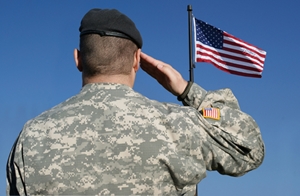Suicide is undoubtedly one of the biggest issues facing the military community. Whether it is soldiers who have separated from service, veterans of Iraq and Afghanistan or active duty troops, it's clear that the rate of servicemembers taking their own lives is on the rise. Though the situation may seem dire, both the Department of Veterans Affairs and Pentagon plan on taking steps to address the problem in the coming years, and there are many resources available to soldiers grappling with depression, post-traumatic stress disorder (PTSD) and other conditions that may raise the risk of suicide.
Issue on the rise
There's no question 2012 was a bad year for suicide in the military. Pentagon statistics show 349 soldiers took their own lives last year, which was up considerably from the 301 in 2011 and also more than the 295 Americans who were killed in combat. In response to the startling statistics, Senator Patty Murray, the former chairman of the Committee on Veterans' Affairs, said that her colleagues in Congress should do more to address the issue.
"This is an epidemic that cannot be ignored," she said earlier this year, according to The Associated Press. "As our newest generation of servicemembers and veterans face unprecedented challenges, today's news shows we must be doing more to ensure they are not slipping through the cracks."
Pentagon recognizes the issue
Given the rise in the number of soldiers committing suicide, it's no surprise that the Pentagon has made prevention a priority. Still, experts say addressing suicide in the military is not an easy task. Kim Ruocco, who heads a suicide prevention program Tragedy Assistance Program for Survivors (TAPS), says that it's near impossible to be with an at-risk individual every hour of the day to make sure they don't take their own lives. Instead, she says the goal is to recognize risk factors, whether they be PTSD, substance abuse, or trouble transitioning, and make soldiers aware that there are resources available to them.
"Now that we're decreasing our troops and they're coming back home, that's when they're really in the danger zone," Ruocco, whose husband killed himself in 2005 after serving in Iraq, told the AP.
Glimmers of progress
The situation may seem dire, but some outposts in the military have shown success in preventing suicides, including Fort Bliss. The New Mexico installation had the lowest suicide rate in the military during 2012 and actually saw a decrease from 2011 to 2012. Officials at Fort Bliss say there is no one magic solution to curbing suicide rates, but rather a well-rounded approach to risk education and resilience may be the best method. The base has also made a concerted effort to reduce behaviors such as drug abuse, motor vehicle accidents and other deaths that can be prevented.
"Our approach creates layer upon layer upon layer of safety nets," explained Army Lt. Col. Leonard Gruppo.
Resources available
Veterans and active duty soldiers should know that they have resources available to them if they are considering suicide. Specifically, the Department of Veterans Affairs (VA) operates a 24-hour counseling service not only to soldiers, but also to their family members. Known as the Veterans Crisis Line, servicemembers can either dial 1-800-273-8255 and press 1, visit www.VeteransCrisisLine.net or text 838255. Since it was launched in 2007, the line has fielded more than 650,000 calls. There are a number of other places soldiers can turn as well, including the National Suicide Prevention Hotline, which can be reached at 1-800-273-TALK (8255).

